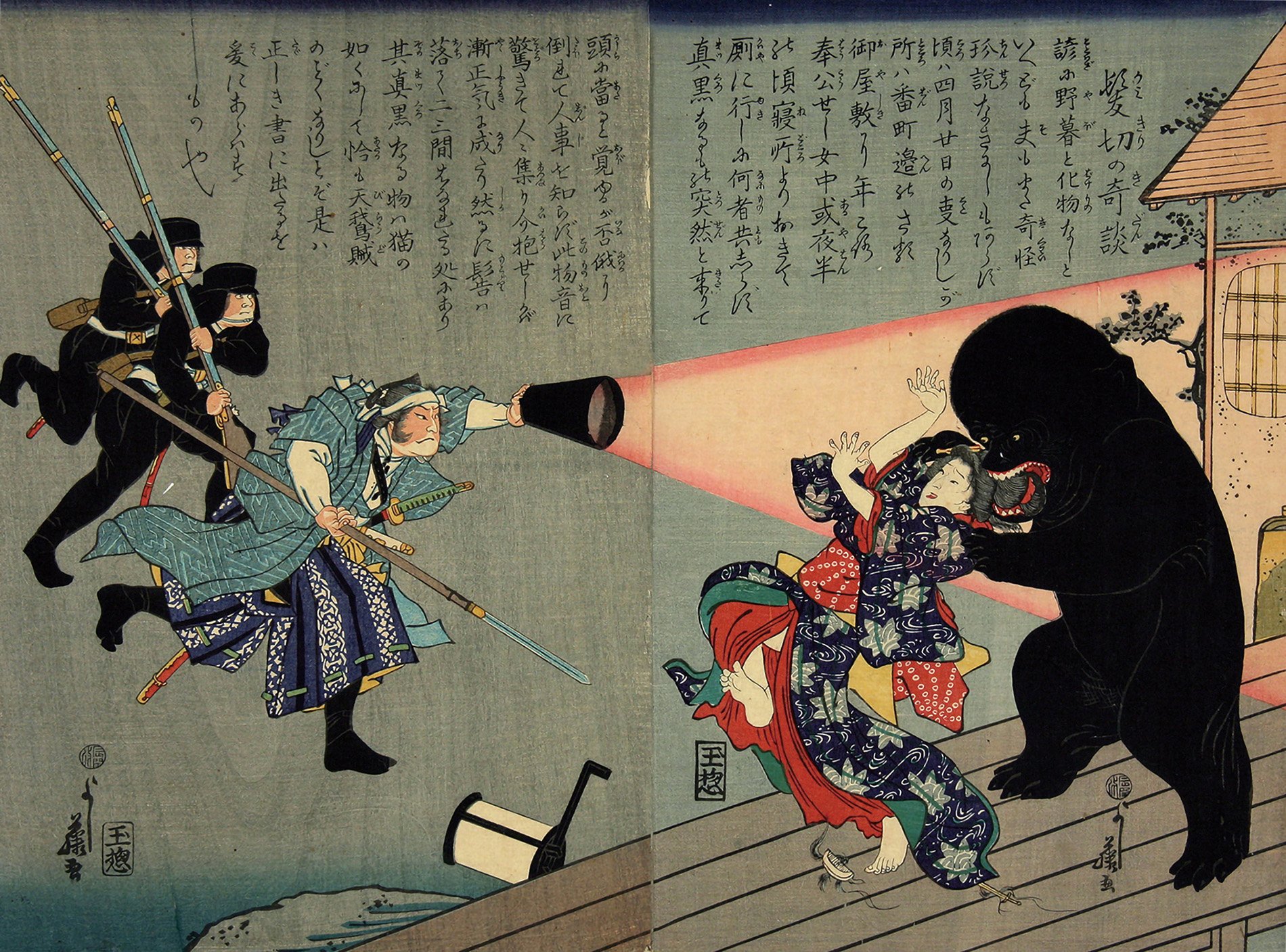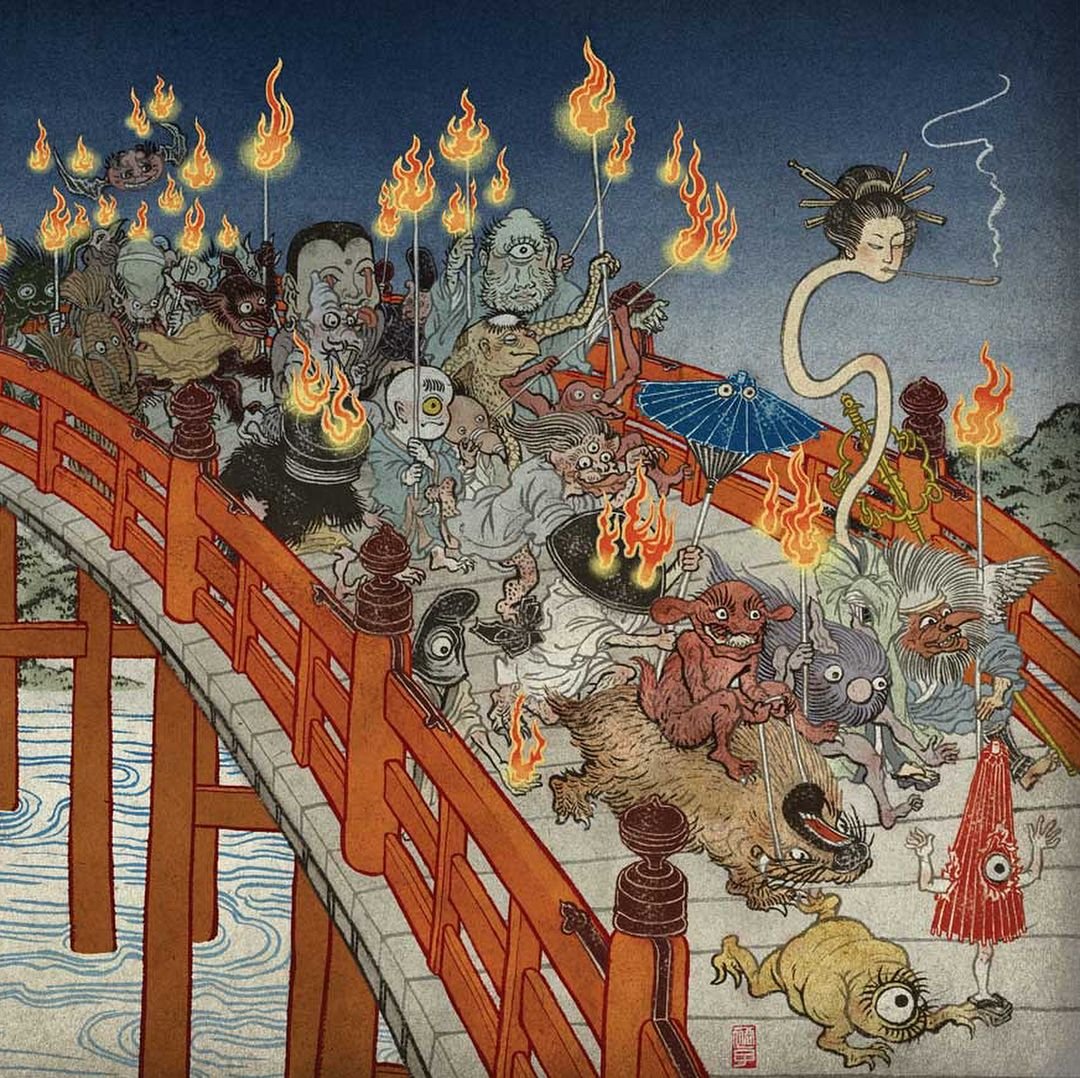Shadow of the Yokai: Japanese Myths, Folklore and Their Impact Today

For anyone being exposed to Japanese culture, it’s almost impossible to not have come across the word yokai.
Misled by a generalized explanation of the term, some might think the word simply refers to a specific group of monsters generated by Japanese culture in the same way Western cultures have fairies, leprechauns, trolls, and goblins. Actually, yokai does not translate to “monster” or “specter”, but rather “strange apparition” or “unexplainable phenomena”. With this understanding, the realm of yokai is much more comprehensible.
The word yokai has been observed since ancient Japanese civilizations to justify the unexplainable. It gave reason to tragedies like people drowning in rivers, believed to be caused by an aquatic creature named Kappa who dragged people down to the bottom, or the resonance of echoes caused by an entity called Yamabiko. With time, more and more yokai were added to the list.
Kidomaru by Utagawa Kuniyoshi
The variety of these creatures and apparitions made each of them unique, whether they were common or regional. Some were thought to be evil but willing to help people under certain circumstances and others were attributed special abilities, which bloomed interest, creating an aura of fear and fascination around this eerie subculture.
A yōkai print by Kawanabe Kyōsai
Historically, Japanese society has always been polytheistic and animistic way before the introduction of other religious beliefs; without a singular and omnipresent deity, respecting the surrounding environment and nature greatly enhanced the importance of yokai. Some of these deities were praised as guardians of rivers, forests, and mountains since they were thought to inhabit such places and people living near would dedicate rituals to stay on their “good side”. However, as early as the 13th century, new kinds of yokai started to appear in scrolls: on top of common deities, daily objects came alive.
Yokai by Utagawa Kuniyoshi
This marked a shift in the yokai imaginary because, until this moment, they were mostly related to natural elements and events, but blending with endemic animism beliefs, it was thought that mistreating an object and discarding it without the proper ceremonies could lead to its soul to corrupt and transform into a mischievous yokai.
Takiyasha the Witch and the Skeleton Specter by Utagawa Kuniyoshi
Thanks to the very first illustrations of these entities, this folklore began to spread all over the country due to exposure and popularity among artists. Yokai descriptions have been seen in books, scrolls, and xylographies. One of the most famous works entirely dedicated to the illustration of yokai was produced by the ukiyo-e master Toriyama Sekien titled “The Illustrated Night Parade of One Hundred Demons” [画図百鬼夜行] during the Edo period in 1776, showcasing an encyclopedic approach to the representation of every single yokai known.
The Illustrated Night Parade of One Hundred Demons
The Edo period marks one of the most important phases of Japanese history in terms of fine art and artistic production in general; thanks to the rise of the wealth of merchants and mainly the middle class, more and more people were able to buy prints and books, resulting in the continuous demand for material and new art. At this point, yokai were such a popular belief that countless stories and legends were created, especially to spook citizens out since it was becoming a popular activity.
This is what inserted spirits and ghosts into mainstream folklore as we know it today. The cultural phenomena became a trend to the point that it appeared on card games for kids, and board games, and people even wanted to have engravings and pictures of their favorite yokai as a lucky charm. The first garments with depictions of them in the inner lining of kimonos became a very fashionable practice during this time.
"Strange Story of Kamikiri” by Utagawa Yoshifuji
Throughout centuries, stunning work eternalizing yokai has been created by masters and the iconography gathered from hundreds of years ago, if not thousands, is still conserved today. Thanks to ukiyo-e masters like Katsushika Hokusai and Utagawa Kuniyoshi, some of these incredible pieces are recognized worldwide by non-expert eyes for many reasons, but most importantly because these masterpieces are the pillar references for the creation of the best anime, manga, movies, and video games.
Forest Spirits by Hayao Miyazaki from the movie Princess Mononoke.
Yokai subculture has evolved from being feared deities to becoming part of pop culture, and it’s no secret how big of an impact it had on the nation. However, these beliefs have faded in certain eras, making space for new doctrines.
No-Face offering gold to Chihiro. From the Spirited Away by Hayao Miyazaki
Especially during Japan's militarization at the time of WWII, other cultural beliefs were introduced as well as an ultranationalist philosophy which together gave life to a new mindset and attitude towards Nippon traditions. Nevertheless, in the 1960s, the legendary Shigeru Mizuki brought back the punch of yokai culture into the mainstream, thanks to his hit anime and manga “Gegege no Kitaro”. The appeal of these myths was introduced once again to the country, exhuming something that felt forgotten for a long time.
Gegege no Kitaro by Shigeru Mizuki
As Shigeru Mizuki has said in interviews, he was found lost in a massive jungle while deployed in WWII. One night, he states that he was saved by a yokai as he felt a sort of wall preventing him from moving forward in the dark: the following morning, not only did he realize that there was no wall, but also a huge, lethal cliff. This marked an incredible moment for Mizuki as he moved forward to dedicate his life to drawing yokai, which consequently reawakened the Edo period trend while educating millions of people about traditional Japanese folklore in a modern approach. Then, Shigeru was not the only one in Japan using yokai in his creations. It’s thanks to the important presence of yokai in media that the fascination for the myths was welcomed again and brought back into the entertainment domain.
Yokai by Shigeru Mizuki
It would be impossible to count how many other projects indulged in this subculture. What stands out is the modern evolution of yokai depictions: at first, they were often represented as mortal enemies, but the designs and characters became more palatable, filtered by different artists, as they shifted towards something cuter and rounder. Without any doubt, yokai can easily be perceived as negative but the kawaii change enhanced their true nature: kind and nice, yet mischievous and trickster. These ideas blending with cultural movements in Japan started to give life to something that was not just a yokai, but a mutation of the original concept.
Yokai inspired painting and headpiece by Takashi Murakami
It rests on speculation but the contemporary presence of yokai seems to have encouraged the Nippon obsession with mascots. A recognizable example of the direct influence would be Pokémon. Just by putting together the pieces given to us by Game Freak and The Pokémon company during the years, the concept of those creatures seems to be clearly related to yokai: they are not animals nor their descendants, and most of them are related to nature thanks to their elemental powers if they aren’t ghosts, specters, or objects.
This observation takes another level if we dig deeper into the franchise, where many times we can find characters worshiping the creatures as deities, impersonating a parallel universe to what Japanese folklore represents in the real world. Like Pokémon, many other popular characters, mascots, and creations have been influenced, proving that myths and legends are incredibly deep-rooted in Japanese society. Undeniably, this represents one of the most recognizable and quintessential aspects of the country’s culture and it’s baffling how much of an impact it has overseas as well.
Pale Man from the movie Pan’s Labyrinth by Guillermo Del Toro
It would be interesting to find out what would have happened if the yokai subculture never developed; maybe the unexplainable would be justified differently, and modern society would be devoid of such phenomena. Overall, this huge cultural imaginary doesn’t seem to slow down and will probably continue to thrive, expanding in newer domains. It’s thrilling to think about where the boundaries will be pushed, but on the other hand, it’s important to celebrate the world of yokai where it is today.
About The Author:
Alessandro Nobile`s life started with a Super Nintendo.
Now he`s in Japan studying the language and exploring local culture.






















